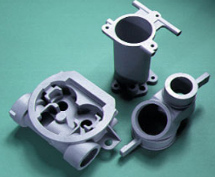 Investment casting has the potential to create monolithic cast systems, which replace multi-piece fabrications from solid hog-outs. This has provided a new perspective for manufacturing engineers to conceive, while designing new structures. The superior design attributes of investment casting has made it useful in a variety of industrial applications, including – aerospace, defense, electronics, optical, mechanical engineering, civil, and more.
Investment casting has the potential to create monolithic cast systems, which replace multi-piece fabrications from solid hog-outs. This has provided a new perspective for manufacturing engineers to conceive, while designing new structures. The superior design attributes of investment casting has made it useful in a variety of industrial applications, including – aerospace, defense, electronics, optical, mechanical engineering, civil, and more.
Some of the design attributes of investment casting include -
- Castings with isotropic properties have similar material attributes in all directions, as contradicted to the big differences between the longitudinal and transverse characteristics of wrought alloys generally used. This simplifies the analysis requirements for stress engineers and they can use a single level of material characteristics or finite element modeling of their 3D CAD designs.
- In conventional fabrications – the flexibility of fasteners (bolts, rivets), stress risers in fastener holes, and the variations in installation of fasteners, induce the design knockout factors for strength that are not applied to single piece castings. Structures also generally fail at joints, hence with decrease in number of joints, the structure becomes more reliable and predictable in performance.
- The inherent stiffening capability of investment castings with complex “T” stiffeners, undulating walls, return flanges and co-incidental fluid coring passageways ensure enhanced designs in both the static as well as dynamic loading cases. This is because of the more efficient transfer of stresses from one point load to the overall structure. This enables the designer to decrease overall thickness and save weight.
 Classic assemblies are constructed by assembling large number of machined or bent sheet metal parts. Since each part has its own dimensional variation, piling large number of parts together manifolds the overall er Investment Castingror. Tolerance stack-up, metal shims to align these interface areas, or use of liquid shims, and requirement for in-the-field customized joints, are expensive drivers in traditional structures. Castings are unitary systems with a centralized datum structure and guaranteed interface points for superior fit.
Classic assemblies are constructed by assembling large number of machined or bent sheet metal parts. Since each part has its own dimensional variation, piling large number of parts together manifolds the overall er Investment Castingror. Tolerance stack-up, metal shims to align these interface areas, or use of liquid shims, and requirement for in-the-field customized joints, are expensive drivers in traditional structures. Castings are unitary systems with a centralized datum structure and guaranteed interface points for superior fit.- Junction of walls for a structure generally takes place at attach points or mounting lugs. Traditional machined “hog-out” shapes often fly with undue weight, as it generally is not feasible to machine away low stress material in tight unaccessible areas. The design of castings allow the designers to thin and thicken areas based on the requirements of load instead of productivity constraints.
- Stress redistribution of monolithic casting design, eradicates fears of conventional beam and frame assemblies buckling and failing at certain loads on the built-up assembly. Enhanced designs in single piece castings allow more efficient distribution of loads throughout the structure. Likewise, the defects such as holes or saw cuts brought into the structure do not spread freely because of the ability of stresses to redistribute move across the structure.
- The characteristics of crack arrest differ in concept between the castings and fabrications. Conventional fabrications may utilize multi-piece members fastened together to produce either a redundant structure, or one where the crack grows to the extremity of a single sub-assembly. The designs of castings should be creative in order to attain crack arrest or load redundancy, however, and may utilize step sections, parallel ribs and inherent stiffening to both arrest damage in service, as well as to facilitate redundant load paths for conditions of over stress.
 Inspection ability of complex assemblies sometimes require total tear down of the structure, wiInvestment Castingth removal of fasteners and finishes so as to check for cracks. The smooth monolithic characteristic of cast structures makes the detection of crack easy.
Inspection ability of complex assemblies sometimes require total tear down of the structure, wiInvestment Castingth removal of fasteners and finishes so as to check for cracks. The smooth monolithic characteristic of cast structures makes the detection of crack easy.- By replacing various assembled components with a single piece casting, stiffness of large structures and their performance can be improved significantly. Investment casting has emerged as a perfect choice for moderate size complex structures as a one-piece stiffened structure is always mechanically better in comparison to one that has stiffening elements bolted together.
